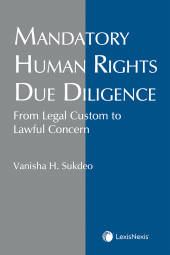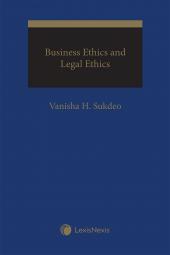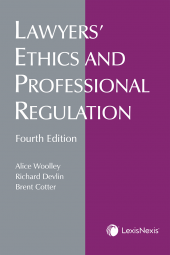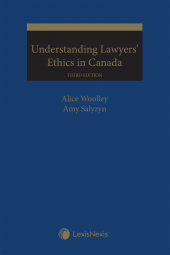Mandatory Human Rights Due Diligence: From Legal Custom to Lawful Concern
One Year Subscription Only Terms
Subscribers receive the product(s) listed on the Order Form and any Updates made available during the annual subscription period. Shipping and handling fees are not included in the annual price.
Subscribers are advised of the number of Updates that were made to the particular publication the prior year. The number of Updates may vary due to developments in the law and other publishing issues, but subscribers may use this as a rough estimate of future shipments. Subscribers may call Customer Support at 800-833-9844 for additional information.
Subscribers may cancel this subscription by: calling Customer Support at 800-833-9844; emailing customer.support@lexisnexis.com; or returning the invoice marked 'CANCEL'.
If subscribers cancel within 30 days after the product is ordered or received and return the product at their expense, then they will receive a full credit of the price for the annual subscription.
If subscribers cancel between 31 and 60 days after the invoice date and return the product at their expense, then they will receive a 5/6th credit of the price for the annual subscription. No credit will be given for cancellations more than 60 days after the invoice date. To receive any credit, subscriber must return all product(s) shipped during the year at their expense within the applicable cancellation period listed above.
Détails des produits
Vanisha H. Sukdeo, an academic and author of this new publication, states in the introduction that the purpose of this book is to examine “how to improve corporate accountability by making corporations responsible for what happens along their supply chains … and how mandatory Human Rights Due Diligence could be implemented to improve the working conditions of … workers in foreign jurisdictions that are outside the reach of Canadian corporate law.”
Mandatory human rights due diligence (mHRDD) is a relatively new field of study; it has developed at the intersection of corporate law and international human rights. While articles have explored this topic, Sukdeo’s Mandatory Human Rights Due Diligence: From Legal Custom to Lawful Concern is the first book to examine it in detail.
The analysis in this volume covers a range of topics – from the 2020 Supreme Court of Canada decision in Nevsun Resources that imposed new obligations on Canadian corporations with global supply chains to international caselaw and recent legislative changes in Norway and Germany. Sukdeo also considers the role that soft law instruments like codes of conduct can play in the protection of the rights of workers. Case studies on the Rana Plaza disaster and the Hudson’s Bay Company provide additional context.
Written in a clear and straightforward manner, Mandatory Human Rights Due Diligence: From Legal Custom to Lawful Concern is an accessible resource that will be useful for lawyers who need to have an understanding of the evolving obligations of Canadian corporations with international supply chains as well as for business professionals who don’t have a legal background.
Media Resources
- What outdoor workers need to know about extreme heat – The Current with Matt Galloway
- Beyond voluntary towards mandatory – Law360 Canada
Table des matières
Chapter 1: Introduction
§ 1.01 Background of the problem
§ 1.02 Purpose of the study
§ 1.03 Framework
§ 1.04 Other frameworks to acknowledge
§ 1.05 Definition of terms
§ 1.06 Contribution
§ 1.07 Research approach
§ 1.08 Shareholder-focused governance
§ 1.09 The divergent paths of corporate law and labour law
§ 1.10 Stakeholder theory
§ 1.11 Mandatory human rights due diligence (“mHRDD”)
§ 1.12 Modern slavery
§ 1.13 The intersection of CSR and workers’ interests
Chapter 2: Codes of Conduct
§ 2.01 Overview of companies with codes that have ties to the Rana Plaza disaster
§ 2.02 Comparison of the 10 codes of conduct
§ 2.03 ILO decent work framework
Chapter 3: Changes to Corporate Governance
§ 3.01 Expansion of fiduciary duties
§ 3.02 Summary of Peoples
§ 3.03 Summary of BCE
§ 3.04 Relevance of BCE
§ 3.05 Peoples, BCE and stakeholder theory
§ 3.06 CBCA and directors’ duties
§ 3.07 Corporate law beyond shareholders
§ 3.08 How has this recent caselaw impacted Canadian corporate law?
§ 3.09 The forgotten (or ignored) stakeholders
Chapter 4: New Caselaw
§ 4.01 Choc v. Hudbay Minerals Inc.
§ 4.02 Chevron Corp. v. Yaiguaje
§ 4.03 Das v. George Weston Ltd.
§ 4.04 Nevsun Resources Ltd. v. Araya
§ 4.05 What comes after Nevsun Resources?
§ 4.06 Canadian Ombudsperson for Responsible Enterprise
§ 4.07 Possible new amendments to the CBCA
§ 4.08 Foreign workers of Canadian companies
§ 4.09 United Nations Global Compact (“UNGC”)
§ 4.10 Mandatory human rights due diligence
§ 4.11 Codes as corporate reformation
§ 4.12 Governance
§ 4.13 International regulation
Chapter 5: Case Study on the Rana Plaza Disaster
§ 5.01 Introduction
§ 5.02 Background
§ 5.03 Who is bound by the code?
§ 5.04 The Accord on Fire and Building Safety in Bangladesh (2013)
§ 5.05 Table – Accord 2013 version
§ 5.06 Accord 2018 version
§ 5.07 Table – Accord 2018 version
§ 5.08 Quarterly aggregate report (January 1, 2021)
§ 5.09 The Alliance for Bangladesh Worker Safety (2013)
§ 5.10 Table – Alliance 2013 version
§ 5.11 Alliance for Bangladesh Worker Safety Fifth Annual Report (November 2018)
§ 5.12 Comparison of the Accord and the Alliance
§ 5.13 The International Accord for Health and Safety in the Textile and Garment Industry
§ 5.14 Table – International Accord (2021)
§ 5.15 Comparison of the Accord (2018) and the new International Accord
§ 5.16 The future for Bangladeshi workers of suppliers who contract with Canadian companies
§ 5.17 Case study conclusion
Chapter 6: Mandatory Human Rights Due Diligence
§ 6.01 From the Ruggie Report to mandatory human rights due diligence (“mHRDD”)
§ 6.02 mHRDD to mHREDD
§ 6.03 What is beyond mHRDD?
Chapter 7: Case Study on the Hudson’s Bay Company
§ 7.01 Introduction
§ 7.02 Background
§ 7.03 History of the HBC
§ 7.04 The company as parent and the company as subsidiary
§ 7.05 Codes of conduct
§ 7.06 The 13 different articles within the model code
§ 7.07 Case study conclusion
Chapter 8: Conclusion
§ 8.01 Fiduciary duties
§ 8.02 Transnational governance as another aspect for workers’ interests
§ 8.03 The corporation and developing countries
§ 8.04 First avenue for future research: What is aspirational versus achievable?
§ 8.05 Next avenue for future research: Corporate law in time and space
§ 8.06 Business ethics
§ 8.07 Transition to weather and work
Index
 Lexis Nexis
Lexis Nexis 


